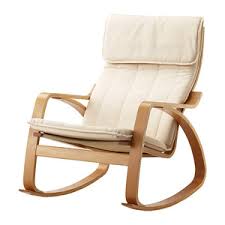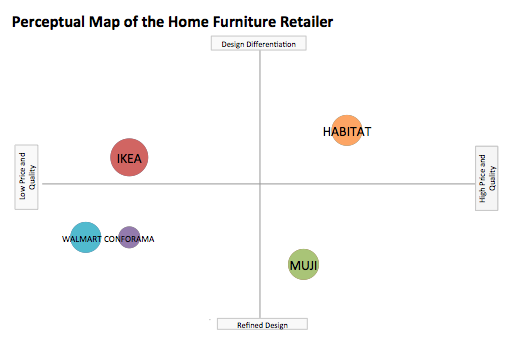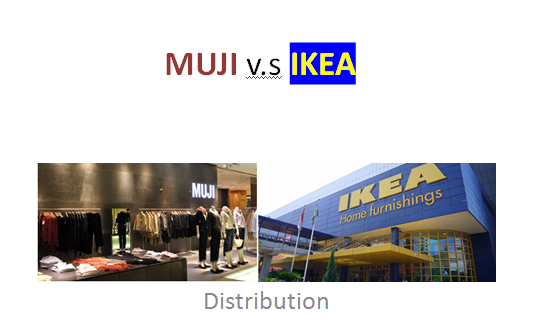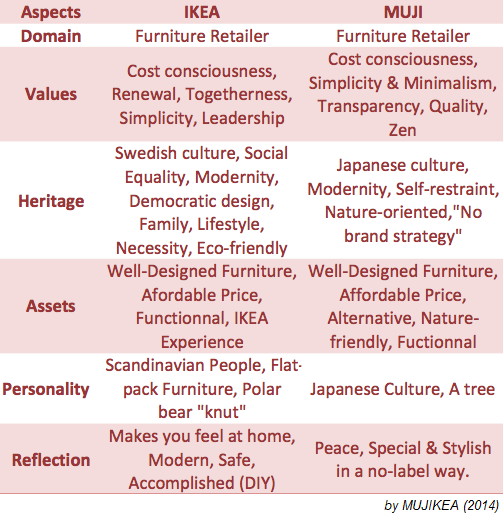|

Demographic
all ages, clear emphasis on values more than demographics
Income
low to middle-high class
Education
all, usually the eco-conscious
Family status
small to medium sized families, catered for families in households with small to middle house space
Gender
Unisex, no strong genderization in products: bland, mostly white or beige and never bright
 Unisex products and furniture at MUJI Paris Target location
- To target Urbanites, mostly metropolitan or areas with high human traffic such as major train stations and popular shopping locations close to these stations. Eg. MUJI in Cologne (Germany) inner-city near main train station, MUJI To-Go at Gare Saint Lazare and Chatelet flagship store (Paris)
 MUJI-to-go at Gare Saint Lazare, Paris, France Values of target market
self-conscious, expressionist, Japanese intrigued, anti-branding, alternative seekers, quality-conscious, compatibility and sensitivity with the earth
Lifestyle
- MUJI shoppers are conscious decision makers and are likely to be loyal as they do not change their lifestyle choices often. MUJIers admire that MUJI chooses their materials responsibly, stay clear to the minimalist attitude and that they are conscious of the environment. MUJI appeals as such to ethical, simplistic, minimalist yet practical shoppers that yet desire for furniture that enhances their lives and are willing to pay more for a lifestyle choice and for the environment.
- Style: MUJIers have a determined style, and prefer to obtain neutral products to complement their existing home design, allowing them room for individuality. MUJI products in return have such tangible simplistic designs that people would notice them. MUJI is also well-known for Iconic and space-saving designs such as their wall-mounted CD Player.
 MUJI’s one of many iconic models: wall-mounted CD Player Targeting messages
- Unlike IKEA, MUJI does not apply aggressive or grandiose marketing to reach its customers but instead, focuses strong on creating the best products to fulfil and benefit customers’ lives, thus focuses strongly on single items.
- The four symbols in MUJI stand for “no-brand quality goods.” To target their market, some of their messages are “In love with no frills”, “From another viewpoint”, “Simple, Functional and Affordable” and “Lower priced for a reason”. This can be attributed to a cost leadership strategy: removing frills to provide affordable prices.The strong “I am” expression of MUJI is thus evolving as an appealing youth brand, the more it emerges in metropolitan areas.
- Sustainability message: Importantly, MUJI’s success image of being originally sustainable before reaching international fame, is popularized by word-of-mouth and propagated along with the anti-brand movement, also the reverse-movement of over-consumption and a way to bring symbolic, unique meanings back into ordinary life.
Emotion Branding
- MUJI communicates their messages through their products, feelings of peace, calmness and a bond to nature. It has integrated itself into lifestyle so well that its branding has become ‘so neutral it must be MUJI’, unlike its original goal to be unrecognizable. Ironically, this desire to eliminate self-expressive benefits actually has evolved to provide self-expressive benefits.
- MUJI’s many different targeting strategies such as “MUJI Yourself” targets self-expressionists and allows them personalization of their MUJI Items.
 MUJI – Yourself at Flagship Store Paris
- MUJI’s simplicity has evolved to become so unique and beautiful in itself, that customers are thrilled to declare they are MUJI fans. The most unbranded furniture made with sustainable materials in neutral colors is now easily mistaken as a MUJI product.
- While MUJI has yet to become a brand religion, as it enters the furniture market, it is emerging rapidly to become a beloved brand and a strong furniture competitor for IKEA.
|

Demographic
All ages, clear emphasis on price more than demographics
Income
low to middle high
Education
all levels
Family status
all families sizes with household ranging from small to large house space, usually young families with children.
Gender
Mixture of Male, Female, Unisex, specific styles: strong and neutral colors
 Genderized and unisex furniture from IKEA Target location
- To target all groups, mostly in the outskirts of cities next to highways to keep costs low, where their warehouses are easily accessible via personal transport or at least by railway trains. Eg. IKEA in France, Sweden and Germany. Only very recently, did they open in the inner-city, the first being in Hamburg, Germany.
 City IKEA at Hamburg, Germany Values of target market
Nordic life, modernist Swedish image, value-for-budget seeking, conformist, collectivism, often non-expressionist, price conscious
Lifestyle
- IKEA shoppers are price-conscious but ambitious to Do-It-Yourself (DIY). They are less likely to be loyal due to the choice for IKEA being only based on price. IKEAers are practical, and often visit IKEA to find everything in one location without considering the effects of over-consumption. They are pleasure seekers who want to be aspired with Nordic design and exotic styles without hurting their budget.
- Style: Aiming at first-timers building a home, IKEAers are usually not future-oriented and purchase the furniture for start-up for ‘new beginnings’, usually in a specific style, color or design. IKEA products in return are so well-known that there exist homes that just look like the catalogue. IKEA is also well-known for their long-running designs such as their POÄNG rocking chair.
 IKEA’s one of many iconic models: POÄNG rocking chair Targeting messages
- Unlike MUJI, IKEA uses with great success its colorful and thick catalogues around Europe and the US to market ‘dreams’ with a focus on many furniture pieces complementing together to form a complete home in specific styles.
- To target their market, some of their messages are “Everything under one roof”, “No matter which style you prefer, there is something for everyone”, “Great design accessible to everyone”. IKEA’s main goal is low prices reaching everyone.
- Sustainability message: Since 2013, IKEA has been aiming to be more sustainable with the launch of its ‘People & Planet Positive’ Strategy, using organic cotton, reducing carbon footprints and renewable energy. Opposite to MUJI, IKEA changed its image towards sustainability after becoming a global brand. By now, IKEA has become so integrated in standard metropolitan life, that most shoppers expect an IKEA shop nearby and purchase more for DIY delight than spiritual desire.
Emotion Branding
- IKEA as a brand and not particularly just its products, communicates happiness, self-fulfillment, and shopper’s relief. Many have grown to love IKEA as it is a dependable brand that offers complete solutions within good prices.
- As more IKEAers build their own furniture, its brand has infiltrated business terminology to form ‘The IKEA Effect,’ what is known to be the over-affection formed for a product after putting labor into it. The craze for DIY has also stirred a community of IKEA Hackers, with a website dedicated to customizing otherwise standard IKEA designs by breaking down its form to create better solutions.
 Example of an IKEA Hack Project
- Moreover, IKEAs foresight to adapt to different cultural needs and expectations has touched all customers globally. The traditional catalogue is adapted according to country. Now there are ‘3D IKEA Catalogues’, rooms re-created completely from paper into real life, allowing shoppers to take pictures there and be transposed onto a personalized IKEA catalogue – a successful way to create emotional connection. Creating the ‘IKEA Family’ Concept has also created strong image that IKEA is family-oriented and cares for the family.
- Now, IKEA is the first word that comes to mind when DIY is mentioned, and brings delight to most when its name is mentioned. It has thus surpassed its boundaries as a brand but also become a brand religion that has left plenty of ‘Lovemarks’ on its consumers.
|
































